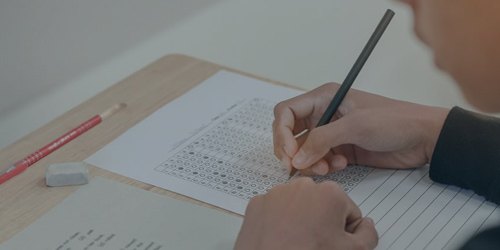WBJEE 2021 Syllabus:
The questions asked in the WBJEE exam are easy but require a lot of smart work, practice and effective preparation. One of the major challenges generally faced by students is the time constraint. To overcome this, students need to develop adept problem-solving skills as well as time management skills to ensure the successful completion of the examination. Moreover, before starting their preparations students should acquire an in-depth and clear understanding of each and every topic covered in the syllabus of WBJEE 2021.
Therefore, candidates should read the syllabus at least once before studying. This exercise will help them gain insight into all the important chapters or topics that they should focus on. Additionally, they can formulate a proper study plan accordingly.
Having said that, here is the subject wise break down of important chapters for WBJJEE 2021. Students need to pay proper attention to these chapters to ace the examination.
WBJEE Physics Syllabus:
The Physics section of WBJEE syllabus carries 40 questions. The syllabus for Physics comprises topics like Kinematics, Optics, Laws of Motion, Properties of Solids and Liquids etc. Take a look at the details WBJEE syllabus for Physics below.
| Subjects | Topics |
|---|---|
| Physics |
|
Some important topics in Physics
| Important Topics | Chapter weightage |
|---|---|
| wave Motion | 5% |
| Nuclear Physics | 5% |
| Solids & Semiconductor Devices | 5% |
| Modern Physics – Atomic Models | 5% |
| Laws of Motion | 4% |
| Rational Motion | 4% |
Physics Syllabus
Physical World, Measurements, Units & dimensions: Units & Dimensions of physical quantities, dimensional analysis & its applications, error in measurements, significant figures.
Kinematics:
Scalars & vectors, representation of vectors in 3D, dot & cross product & their applications, elementary differential & integral calculus, time-velocity & relevant graphs, equations of motion with uniform acceleration.
Laws of motion:
Newton’s laws of motion, using algebra & calculus, inertial & non-inertial frames, conservation of linear momentum with applications, elastic & inelastic collisions, impulse centripetal force, banking of roads, relative velocity, projectile motion & uniform circular motion Work, power, energy: Work, power, energy Work, work-energy theorem, power, energy, work done by constant & variable forces, PE & KE, conservation of mechanical energy, conservative and nonconservative forces, PE of a spring, Motion of centre of mass, connected systems.
Gravitation:
Kepler’s laws, (only statement) universal law of gravitation, acceleration due to gravity (g), a variation of g, gravitational potential & PE, escape velocity, orbital velocity of satellites, geostationary orbits.
Friction:
Centre of the mass of the two-particle system, the motion of the connected system, torque, the equilibrium of rigid bodies, moments of inertia of simple geometric bodies (2D) [without derivation] conservation of angular momentum, friction and laws of friction.
Surface tension:
Surface energy, phenomena involving surface tension, angle of contact, capillary rise.
Bulk properties of matter:
Elasticity, Hooke’s law, Young’s modulus, bulk modulus, shear, rigidity modulus, Poisson’s ratio elastic potential energy. Fluid pressure: Pressure due to a fluid column, buoyancy, Pascal’s law, effect of gravity on fluid pressure.
Viscosity:
Coefficient of viscosity, streamline & turbulent motion, Reynold’s number, Stoke’s law, terminal velocity, Bernoulli’s theorem. Heat & Thermal Physics: Heat & temperature, thermal expansion of solids. liquids & gases, ideal gas laws, isothermal & adiabatic processes; anomalous expansion of water & its effects, sp. heat capacity, Cp, Cv, calorimetry; change of state, specific latent heat capacity. Heat transfer; conduction, thermal and thermometric
conductivity, convection & radiation, Newton’s law of cooling, Stefan’s law.
Kinetic theory of gases:
Equation of state of a perfect gas, kinetic theory of gases, assumptions in Kinetic theory of gases, the concept of pressure. & temperature; rms speed of gas molecules; degrees of freedom, law of equipartition of energy (introductory ideas) & application to specific heats of gases; mean free path, Avogadro number.
Thermodynamics:
Thermal equilibrium (Zeroth law of thermodynamics), heat, work & internal energy. 1st law of thermodynamics, isothermal & adiabatic processes, 2nd law of thermodynamics, reversible & irreversible processes.
Oscillations & Waves:
Periodic motion & time period, frequency, time-displacement equation, Simple harmonic motion (S.H.M) & its equation; phase; SHM in different sytems, restoring force & force const, energy in S.H.M.- KE & PE, free, forced & damped oscillations (introductory ideas), resonance wave motion, the equation for progressive wave, longitudinal & transverse waves, sound waves, Newton’s formula & Laplace’s correction, factors affecting the velocity of sound in air, principles of superposition of waves, reflection of waves, standing waves in strings & organ pipes, fundamental mode, harmonics &overtones, beats, Doppler effect.
Current Electricity:
Electric current, & conductor, drift velocity’ mobility & their relation with electric current; Ohm’s law, electrical resistance, Ohmic and non-Ohmic conductors, electrical energy & power, carbon resistors, colour codes, combination of resistances, temperature dependence of resistances, electric cell, emf and internal resistance of an electric cell, pd, combination of cells, secondary cells, (introductory) Kirchoff’s laws of electrical network, simple applications, principle of Wheatstone bridge, metre bridge and potentiometer and their uses, thermoelectricity; Seebeck effect; Peltier effect, thermo emf.
Electrostatics:
Conservation of electric charges, Coulomb’s law-force between two point charges, forces between multiple charges; superposition principle & continuous charge distribution. Electric field, & potential due to a point charge & distribution of charges, electric field lines electric field due to a dipole; torque on a dipole in uniform electric field; electric flux, Gauss’ theorem & its simple applications, conductors & insulators, free charges & bound charges inside a conductor; dielectrics & electric polarisation, capacitors & capacitance, combination of capacitors in series & in parallel, capacitance of a parallel plate capacitor with & without dielectric medium between the plates, energy stored in a capacitor.
Magnetic effect of current:
Concept of magnetic field, Oersted’s experiment, Biot – Savart law & its application to current carrying circular loop; Ampere’s law & its applications to infinitely long straight wire, straight and toroidal solenoids; force on a moving charge in uniform magnetic & electric fields, cyclotron frequency; force on a current-carrying conductor in a uniform magnetic field, force between two parallel current-carrying conductors– definition of ampere. Torque experienced by a current loop in a uniform magnetic field; moving coil galvanometer-its current sensitivity & conversion to ammeter & voltmeter, Inter-conversion of voltmeter & ammeter & change of their ranges.
Electromagnetic induction & alternating current:
Electromagnetic induction; Faraday’s laws, induced emf & current; Lenz’s Law, eddy currents, self & mutual induction, alternating currents, peak and rms value of alternating current and voltage; reactance and impedance; LR & CR circuits, phase lag & lead, LCR series circuit, resonance; power in AC circuits, wattless current.
Magnetics:
Current loop as a magnetic dipole & its magnetic dipole moment, magnetic dipole moment of a revolving electron, magnetic field intensity due to a magnetic dipole bar magnet along its axis & perpendicular to its axis, torque on a magnetic dipole (bar magnet) in a uniform
magnetic field; magnet as an equivalent solenoid, magnetic field lines; Earth’s magnetic field & its magnetic elements. para-, dia- & ferro- magnetic substances, with examples. Electromagnets
& the factors affecting their strengths, permanent magnets.
Electromagnetic waves:
Electromagnetic waves and their characteristics (qualitative ideas only), transverse nature of electromagnetic waves, electromagnetic spectrum, applications of the waves from the different parts of the spectrum
Atomic Physics:
Alpha-particle scattering expt Rutherford’s nuclear atom model of atom; Bohr model of hydrogen atom, energy levels in a hydrogen atom, hydrogen spectrum, continuous & characteristic xrays.
Nuclear Physics:
Composition & size of nucleus, atomic masses, isotopes, isobars; isotones, radioactivity – alpha, beta & gamma particles/ rays & their properties; radioactive decay law; massenergy relation, mass defect; binding energy per nucleon & its variation with mass number; nuclear fission & fusion.
Solid state Electronics:
Energy bands in solids (qualitative ideas only), conductors, insulators & semiconductors; semiconductor diode & I-V characteristics in forward & reverse bias, diode as a rectifier; I-V characteristics of LED, photodiode, solar cell & Zener diode; Zener diode as a voltage regulator, junction transistor (BJT), transistor action, characteristics of a BJT, BJT as an amplifier (CE configuration) & oscillator; logic gates (OR, AND, NOT, NAND & NOR).
Optics I (Ray optics):
Reflection of light, spherical mirrors, mirror formula. Refraction of light, total internal reflection & its applications, optical fibres, refraction at spherical surfaces, lenses, thin lens formula, lensmaker’s formula.
Newton’s relation:
Displacement method to find position of images (conjugate points) Magnification, power of a lens, combination of thin lenses in contact, combination of a lens & a mirror refraction and dispersion of light through a prism; optical instruments, human eye, image formation & accommodation, correction of eye defects (myopia, hypermetropia) using lenses, microscopes & astronomical telescopes (reflecting & refracting) & their magnifying
powers.
Optics II (Wave Optics): Scattering of light – blue colour of the sky, elementary idea of Raman effect; wave optics wave front & Huygens’ principle, reflection & refraction of plane wave at a plane surface using wave fronts. Proof of laws of reflection & refraction using Huygens’ principle Interference, Young’s double slit experiment & expression for fringe width, coherent sources, Fraunhoffer diffraction due to a single slit, Particle nature of light & wave particle dualism: Photoelectric effect, Hertz and Lenard’s observations; Einstein’s photoelectric equation – particle nature of light, matter waves; wave nature of particles, de Broglie relation
WBjEE Syllabus Chemistry
| Subject | Topics |
|---|---|
| Chemistry |
|
Some Important Topics in Chemistry
| Important topics | Chapter Weightage(In Percent) |
|---|---|
| p- Block Elements | 6% |
| Redox Reaction | 5% |
| Ionic Equilibrium | 4% |
| Chemical Equilibrium | 4% |
| Coordination Compound | 4% |
| Carboxylic Acids & Derivatives | 4% |
| Alcohol Phenol Ether | 4% |
| Chemical Thermodynamics | 4% |
Chemistry Syllabus:
Atomic Structure:
Concept of Nuclear Atom: Electron, proton and neutron (charge and mass), atomic number. Rutherford’s model and its limitations; Extra nuclear structure; Line spectra of hydrogen atom. Quantization of energy (Planck’s equation); Bohr’s model of hydrogen atom and its limitations,
Sommerfeld’s modifications (elementary idea); The four quantum numbers, ground state electronic configurations of many electron atoms and
monoatomic ions; The Aufbau Principle; Pauli’s Exclusion Principle and Hund’s Rule. Dual nature of matter and light, de Broglie’s relationship, Uncertainty principle; The concept of atomic orbitals, shapes of s, p and d orbitals (pictorial approach).
Atoms, Molecules and Chemical Arithmetic:
Dalton’s atomic theory; Gay Lussac’s law of gaseous volume; Avogadro’s Hypothesis and its applications. Atomic mass; Molecular mass; Equivalent weight; Valency; Gram atomic weight; Gram molecular weight; Gram equivalent weight and mole concept; Chemical formulae; Balanced chemical equations; Calculations (based on mole concept) involving common oxidation – reduction, neutralization, and displacement reactions; Concentration in terms of mole fraction, molarity, molality and normality. Percentage composition, empirical formula and molecular formula; Numerical problems.
The Periodic Table and Chemical Families:
Modern periodic law (based on atomic number); Modern periodic table based on electronic configurations, groups (Gr. 1-18) and periods. Types of elements representative (s-block and pblock), transition (d-block) elements and inner transition (f-block/lanthanides and actinides) and their general characteristics. Periodic trends in physical and chemical properties- atomic radii, valency, ionization energy, electron affinity, electronegativity, metallic character, acidic and basic characters of oxides and hydrides of the representative elements (up to Z = 36). Position of hydrogen and the noble gases in the periodic table; Diagonal relationships.
Radioactivity and Nuclear Chemistry:
Radioactivity and their properties; Artificial transmutation; Rate of radioactive decay, decay constant, half-life and average age life period of radio-elements; Units of radioactivity; Numerical problems. Stability of the atomic nucleus effect of neutron-proton (n/p) ratio on the
modes of decay, group displacement law, radioisotopes and their uses (C, P, Co and I as examples) isobars and isotones (definition and examples), elementary idea of nuclear fission and fusion reactions.
Coordination Compounds:
Introduction, Double salts and complex salts, coordination compounds (examples only), Werner’s theory, coordination number (examples of coordination number 4 and 6 only), colour, magnetic properties and shapes, IUPAC nomenclature of mononuclear coordination compounds.
Chemical Bonding and Molecular Structure:
Valence electrons, the Octet rule, electrovalent, covalent and coordinate covalent bonds with examples; Properties of electrovalent and covalent compounds. Limitations of Octet rule (examples); Fajans Rule. Directionality of covalent bonds, shapes of poly atomic molecules (examples); Concept of hybridization of atomic orbitals (qualitative pictorial approach): sp, sp2 , sp3 and dsp2 . Molecular orbital energy diagrams for homonuclear diatomic species bond order and magnetic properties. Valence Shell Electron Pair Repulsion (VSEPR) concept (elementary idea) shapes of molecules. Concept of resonance (elementary idea), resonance structures (examples). Elementary idea about electronegativity, bond polarity and dipole moment, interand intra-molecular hydrogen bonding and its effects on physical properties (mp, bp and solubility); Hydrogen bridge bonds in diborane.
Solid State:
Classification of solids based on different binding forces: molecular, ionic, covalent and metallic solids, amorphous and crystalline solids (elementary idea). Unit cell in two dimensional and three dimensional lattices, calculation of density of unit cell, packing in solids, packing
efficiency, voids, number of atoms per unit cell in a cubic unit cell, point defects, electrical and magnetic properties. Band theory of metals, conductors, semiconductors and insulators and n & p type semiconductors.
Liquid State:
Vapour pressure, viscosity and surface tension (qualitative idea only, no mathematical derivations).
Gaseous State:
Measurable properties of gases. Boyle’s Law and Charles Law, absolute scale of temperature, kinetic theory of gases, ideal gas equation average, root mean square and most probable velocities and their relationship with temperature. Daltons Law of partial pressure, Grahams Law of gaseous diffusion. Deviations from ideal behavior. Liquefaction of gases, real gases, van der Waals equation; Numerical problems.
Chemical Energetics and Chemical Dynamics:
Chemical Energetics Conservation of energy principle, energy changes in physical and chemical transformations. First law of thermodynamics; Internal energy, work and heat, pressure volume work; Enthalpy. Internal energy change and Enthalpy change in a chemical reaction. Hesss Law
and its applications (Numerical problems). Heat of reaction, fusion and apourization; Second law of thermodynamics; Entropy; Free energy; Criterion of spontaneity. Third law of thermodynamics (brief introduction).
Chemical Equilibria The Law of mass action, dynamic nature of chemical equilibria. Equilibrium constants, Le Chateliers Principle. Equilibrium constants of gaseous reactions (Kp and Kc) and relation between them (examples). Chemical Dynamics Factors affecting the rate of chemical reactions (concentration, pressure, temperature, catalyst), Concept of collision theory. Arrhenius equation and concept of activation energy.
Order and molecularity (determination excluded); First order reactions, rate constant, half life (numerical problems), examples of first order and second order reactions.
Physical Chemistry of Solutions:
Colloidal Solutions Differences from true solutions; Hydrophobic and hydrophilic colloids (examples and uses); Coagulation and peptization of colloids; Dialysis and its applications;
Brownian motion; Tyndall effect and its applications; Elementary idea of emulsion, surfactant and micelle.
Electrolytic Solutions Specific conductance, equivalent conductance, ionic conductance, Kohlrausch’s law, Faraday’s laws of electrolysis, applications. Numerical problems. Non-electrolytic Solutions Types of solution, vapour pressure of solutions. Raoult’s Law;
Colligative properties lowering of vapour pressure, elevation of boiling point, depression of freezing point, osmotic pressure and their relationships with molecular mass (without derivations); Numerical problems.
Ionic and Redox Equilibria:
Ionic equilibria ionization of weak electrolytes, Ostwald’s dilution law. Ionization constants of weak acids and bases, ionic product of water, the pH scale, pH of aqueous solutions of acids and bases; Buffer solutions, buffer action and Henderson equation. Acid-base titrations, acid base indicators (structures not required). Hydrolysis of salts (elementary idea), solubility product, common ion effect (no numerical problems).
Redox Equilibria:
Oxidation Reduction reactions as electron transfer processes, oxidation numbers, balancing of redox reactions by oxidation number and ion-electron methods. Standard electrode potentials (E°), Electrochemical series, feasibility of a redox reaction. Significance of Gibb’s equation (without derivation), no numerical problems. Redox titrations with (examples); Nernst equations (Numerical problems).
Hydrogen:
Position of hydrogen in periodic table, occurrence, isotopes, preparation, properties and uses of hydrogen, hydrides-ionic covalent and interstitial; physical and chemical properties of water, heavy water, hydrogen Peroxide preparation, reactions and structure and use; hydrogen as a fuel.
Chemistry of Non-Metallic Elements and their Compounds:
Carbon occurrence, isotopes, allotropes (graphite, diamond, fullerene); CO and CO2 production, properties and uses. Nitrogen and Phosphorus occurrence, isotopes, allotopes, isolation from natural sources and purification, reactivity of the free elements. Preparation, properties, reactions of NH3, PH3, NO, NO2, HNO2, HNO3, P4O10, H3PO3 and H3PO4. Oxygen and Sulphur Occurrence, isotopes, allotropic forms, isolation from natural sources and purification, properties and reactions of the free elements. Water, unusual properties of water, heavy water (production and uses). Hydrogen peroxide and ozone (production, purification, properties and uses).
Halogens comparative study, occurrence, physical states and chemical reactivities of the free elements, peculiarities of fluorine and iodine; Hydracids of halogens (preparation, properties, reactions and uses), inter- halogen compounds (examples); Oxyacids of chlorine.
Chemistry of Metals:
General principles of metallurgy occurrence, concentration of ores, production and purification of metals, mineral wealth of India. Typical metals (Na, Ca, Al, Fe, Cu and Zn) occurrence, extraction, purification (where applicable), properties and reactions with air, water, acids and non-metals. Manufacture of steels and alloy steel (Bessemer, Open-Hearth and L.D. process). Principles of chemistry involved in electroplating, anodizing and galvanizing. Preparation and properties of K2Cr2O7 and KMnO4. Lanthanoids Electronic configuration, oxidation states, chemical reactivity and lanthanoid contraction and its consequences. Actinoids Electronic configuration, oxidation states and comparison with lanthanoids.
Chemistry in Industry:
Large scale production (including physicochemical principles where applicable, omitting technical details) and uses of Sulphuric acid (contact process), Ammonia (Haber’s process), Nitric acid (Ostwald’s process), sodium bi- carbonate and sodium carbonate (Solvey process).
Polymers:
Natural and synthetic polymers, methods of polymerization (addition and condensation), copolymerization, some important polymers natural and synthetic like polythene, nylonpolyesters, bakelite, rubber. Biodegradable and non-biodegradable polymers.
Surface Chemistry:
Adsorption physisorption and chemisorption, factors affecting adsorption of gases on solids, catalysis, homogenous and heterogenous activity and selectivity; enzyme catalysis colloidal state distinction between true solutions, colloids and suspension; lyophilic , lyophobic multimolecular and macromolecular colloids; properties of colloids; Tyndall effect, Brownian movement, electrophoresis, coagulation, emulsion types of emulsions.
Chemistry of Carbon Compounds:
Hybridization of carbon bonds. Isomerism constitutional and stereoisomerism; Geometrical and optical isomerism of compounds containing upto two asymmetric carbon atoms. IUPAC nomenclature of simple organic compounds hydrocarbons, mono and bifunctional molecules only (alicyclic and heterocyclic compounds excluded).
Environmental Chemistry:
Common modes of pollution of air, water and soil. Ozone layer, ozone hole important chemical reactions in the atmosphere, Smog; major atmospheric pollutants; Green House effect; Global warming pollution due to industrial wastes, green chemistry as an alternative tool for reducing pollution, strategies for control of environment pollution. Conformations of ethane and nbutane (Newman projection only). Electronic Effects: Inductive, resonance and hyperconjugation. Stability of carbocation, carbanion and free radicals; Rearrangement of carbocation; Electrophiles and nucleophiles, tautomerism in β-dicarbonyl compounds, acidity and basicity of simple organic compounds.
Compounds:
Haloalkanes and Haloarenes:
Haloalkanes Preparation from alcohols; Nomenclature, nature of C -X bond, physical and chemical properties, mechanism of substitution reactions, optical rotation. Formation of Grignard reagents and their synthetic applications for the preparation of alkanes, alcohols, aldehydes, ketones and acids; SN1 and SN2 reactions ( preliminary concept ). Uses and environmental effects of – dichloromethane, trichloromethane, tetrachloromethane, iodoform, freons, DDT. Alkanes Preparation from alkyl halides and carboxylic acids; Reactions halogenation and
combustion. Alkenes and Alkynes Preparation from alcohols; Formation of Grignard reagents and their synthetic applications for the preparation of alkanes, alcohols, aldehydes, ketones and acids; SNl and SN2 reactions (preliminary concept). Markownikoff’s and anti-Markownikoff’s
additions; Hydroboration; Oxymercuration-demercuration, reduction of alkenes and alkynes (H2/Lindler catalyst and Na in liquid NH3), metal acetylides.
Alcohols:
Preparation of alcohols from carbonyl compounds and esters. Reaction dehydration, oxidation, esterification, reaction with sodium, ZnCl2/HCl, phosphorous halides. Ethers Preparation by Williamson’s synthesis; Cleavage with HCl and HI. Aldehydes and Ketones Preparation from esters, acid chlorides, gem-dihalides, Ca-salt of carboxylic acids. Reaction Nucleophilic addition with HCN, hydrazine, hydroxyl amines, semi carbazides, alcohols; Aldol condensation, Clemmensen and Wolff Kishner reduction, haloform, Cannizzaro and Wittig reactions. Carboxylic Acids Hydrolysis of esters (mechanism excluded) and cyanides; Hunsdicker and HVZ reactions. Aliphatic Amines Preparation from nitro, cyano and amido compounds. Distinction of 1º, 2º and 3º amines (Hinsberg method); Reaction with HNO2; Carbyl amine reaction.
Aromatic Compounds:
Amines Preparation from reduction of nitro compounds; Formation of diazonium salts and their stability;
Replacement of diazonium group with H, OH, X (halogen), CN and NO2, diazocoupling and reduction.
Haloarenes Nature of C -X bond, substitution reactions; Nucleophilic substitution, cine substitution (excluding mechanism, Directive influence of halogen in monosubstituted compounds only).
Phenols halogenation, sulfonation, nitration, Reimer Tiemann and Kolbe reactions. Aromatic Aldehydes Preparation by Gattermann, Gattermann-Koch, Rosenmund and Stephen’s method. Reactions Perkin, Benzoin and Cannizzaro. Benzene Kekule structure, aromaticity and Hückel rule. Electrophilic substitution halogenation, sulfonation, nitration, Friedel Crafts reaction, ozonolysis. Directive influence of substituents in monosubstituted benzenes. Carcinogenicity and toxicity.
Application Oriented chemistry:
Main ingredients, their chemical natures (structures excluded) and their side effects, if any, of common antiseptics, analgesics, antacids, vitamin-C.
Introduction to Bio-Molecules:
Carbohydrates Pentoses and hexoses. Distinctive chemical reactions of glucose. Aminoacids glycine, alanine, aspartic acid, cysteine (structures). Zwitterion structures of amino acids, peptide bond. ADP and ATP structures and role in bioenergetics; Nucleic acids DNA and RNA skeleton structures. Names of essential elements in biological system.
Principles of Qualitative Analysis:
Detection of water soluble non-interfering Acid and Basic Radicals by dry and wet tests from among: Detection of special elements (N, Cl, Br, I and S) in organic compounds by chemical tests. Identification of functional groups in: phenols, aromatic amines, aldehydes, ketones and carboxylic acids
WBJEE Syllabus Mathematics
| subject | Topics |
|---|---|
| Mathematics |
|
Important Topics in Mathematics
| Important topics | Chapter weightage |
|---|---|
| Probability | 7% |
| Vectors | 7% |
| 3-D Geometry | 6% |
| Matrices & Determinants | 5% |
| Limits | 5% |
| Indefinite Integration | 5% |
| Sets, Relation & Functions | 5% |
| Definite Integration | 4% |
| Theory of Equations | 4% |
Mathematics Syllabus
Algebra
- A.P., G.P., H.P.:Summation of first n-terms
- Logarithms: Definition; General properties; Change of base.
- Arithmetic/Geometric series, A.M., G.M. and their relation; Infinite G.P. series and its sum.
- Solution of quadratic equation in complex number system.
Complex Numbers:
Definition and properties of complex numbers; Complex conjugate; Triangle inequality; Square root of complex numbers; Cube roots of unity; De Moivre’s theorem (statement only) and its elementary applications.
Quadratic Equations:
Quadratic equations with real coefficients; Relations between roots and coefficients; Nature of roots; Formation of a quadratic equation, sign and magnitude of the quadratic expression ax2 +bx+c (where a, b, c are rational numbers and a ≠0).
Matrices:
Concepts of mXn real matrices, operations of addition, scalar multiplication and multiplication of matrices. Transpose of a matrix. Determinant of a square matrix. Properties of determinants (statement only). Minor, cofactor and adjoint of a matrix. Nonsingular matrix. Inverse of a matrix. Finding area of a triangle. Solutions of system of linear equations. (Not more than 3 variables).
Permutation and combination:
Permutation of n different things taken r at a time (r ≤ n). Permutation of n things not all different. Permutation with repetitions (circular permutation excluded). Combinations of n different things taken r at a time. Combination of n things not all different. Basic properties. Problems involving both permutations and combinations.
Principle of mathematical induction
Relation and its properties. Equivalence relation definition and elementary examples, mappings, range and domain, injective, surjective and bijective mappings, composition of mappings, inverse of a mapping.
Binomial theorem (positive integral index): Statement of the theorem, general term, middle term, equidistant terms, properties of binomial coefficients.
Sets, Relations and Mappings: Idea of sets, subsets, power set, complement, union, intersection and difference of sets, Venn diagram, De Morgan’s Laws, Inclusion / Exclusion formula for two or three finite sets, Cartesian product of sets.
Statistics and Probability: Measure of dispersion, mean, variance and standard deviation, frequency distribution. Addition and multiplication rules of probability, conditional probability and Bayes’ Theorem, independence of events, repeated independent trails and Binomial distribution.
Trigonometry
Trigonometry: Trigonometric functions, addition and subtraction formula, formula involving multiple and sub multiple angles, general solution of trigonometric equations. Properties of triangles, inverse trigonometric functions and their properties.
Two dimensions Coordinate geometry: Distance formula, section formula, area of a triangle, condition of colinearity of three points in a plane. Polar coordinates, transformation from Cartesian to polar coordinates and vice versa. Parallel transformation of axes, concept of locus, elementary locus problems. Slope of a line. Equation of lines in different forms, angle between two lines. Condition of perpendicularity and parallelism of two lines. Distance of a point from a line. Distance between two parallel lines. Lines through the point of intersection of two lines. Equation of a circle with a given center and radius. Condition that a general equation of second degree in x,y may represent a circle. Equation of a circle in terms of endpoints of a diameter . Equation of tangent, normal and chord. Parametric equation of a circle. Intersection of a line with a circle. Equation of common chord of two intersecting circles. Definition of conic section, Directrix, Focus and Eccentricity, classification based on eccentricity. Equation of Parabola, Ellipse and Hyperbola in standard form, their foci, directrices, eccentricities and parametric equations.
Three dimensions Co-ordinate geometry: Direction cosines and direction ratios, distance between two points and section formula, equation of a straight line, equation of a plane, distance of a point from a plane.
Calculus
Differential calculus: Functions, composition of two functions and inverse of a function, limit, continuity, derivative, chain rule, derivative of implicit functions and functions defined parametrically. Rolle’s Theorem and Lagrange’s Mean Value theorem (statement only). Their geometric interpretation and elementary application. L’Hospital’s rule (statement only) and applications. Second order derivative.
Integral calculus:
Integration as a reverse process of differentiation, indefinite integral of standard functions. Integration by parts. Integration by substitution and partial fraction. Definite integral as a limit of a sum with equal subdivisions. Fundamental theorem of integral calculus and its applications. Properties of definite integrals.
Differential Equations:
Formation of ordinary differential equations, solution of homogeneous differential equations, separation of variables method, linear first order differential equations.
Application of Calculus:
Tangents and normals, conditions of tangency. Determination of monotonicity, maxima and minima. Differential coefficient as a measure of rate. Motion in a straight line with constant acceleration. Geometric interpretation of definite integral as area, calculation of area bounded by elementary curves and Straight lines. Area of the region included between two elementary curves.
Vectors:
Addition of vectors, scalar multiplication, dot and cross products, scalar triple product











